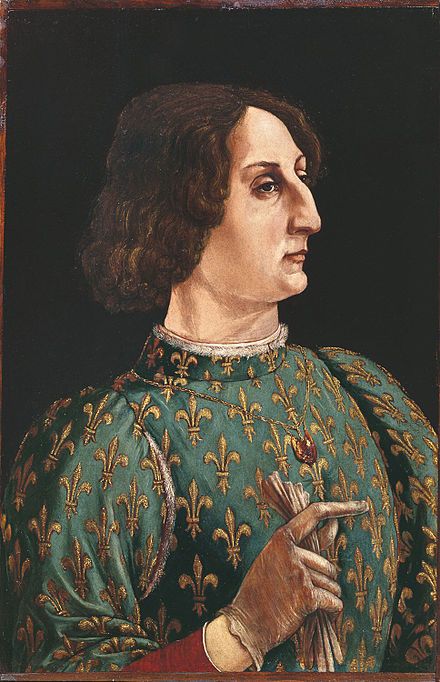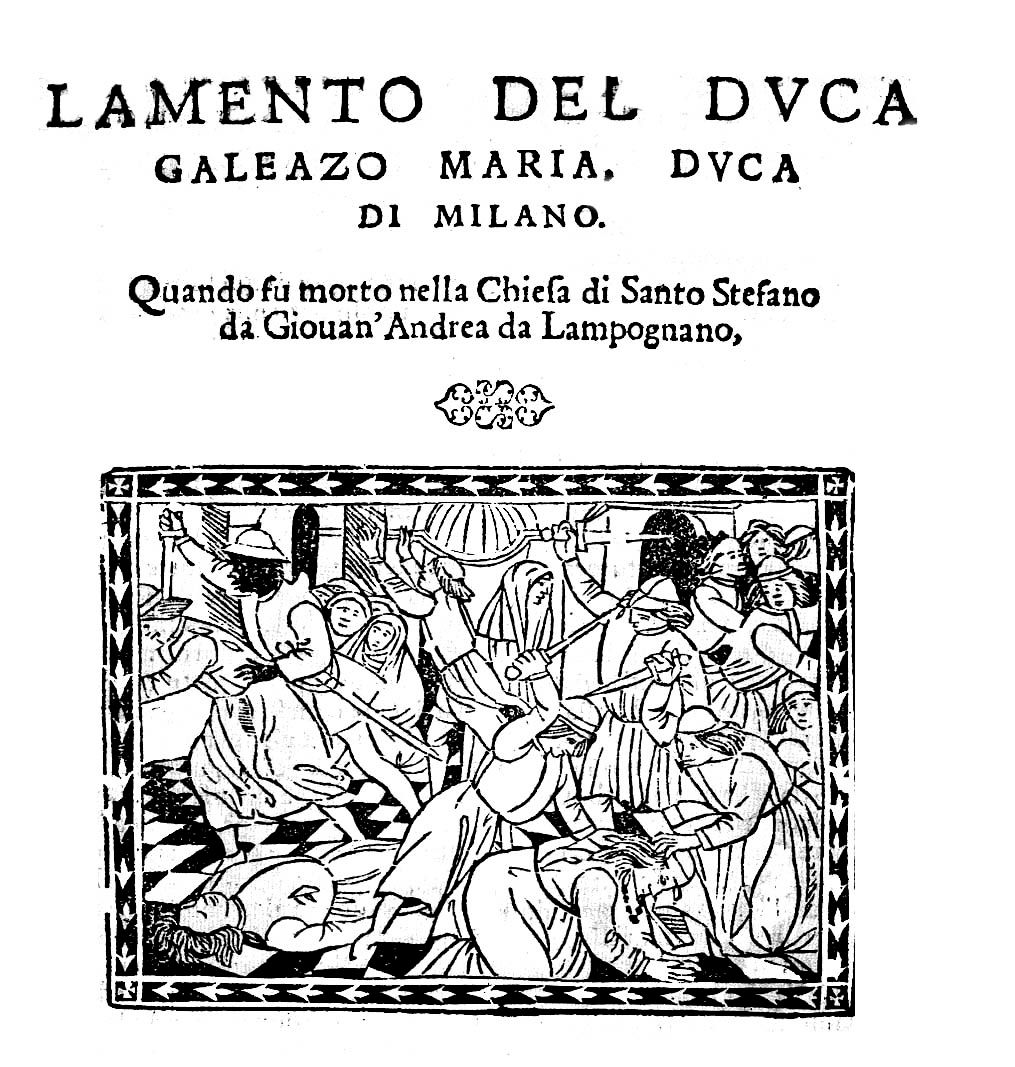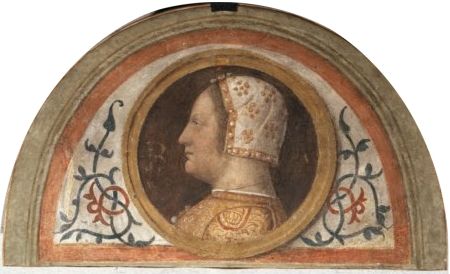All childhoods end, one way or another. Some terminate happily, others less so. For Caterina Sforza, the transition from the relatively carefree life of a child to the sobering realities of adulthood was doubly traumatizing, due to the actions of her father.
In a short span of time, Caterina Sforza would go from a child to a married child and half an orphan.The cause of both these incidences was her mercurial father, Galeazzo Maria Sforza. He was a keen player of the Italian political game, always seeking for an advantage. Frequently these advantages came in the form of marrying off a son or daughter to powerful people.

In 1473, Galeazzo Maria Sforza got the chance of the lifetime. A rival power backed out of a marriage deal with the papal nephew, Girolamo Riario, leaving the door swinging open for Milanese interests to insert themselves into papal politics.Permit me to explain what the papal nephew is.
Girolamo Riario would have been a nobody if he hadn't been related by blood to Pope Sixtus IV. Historian Orville Prescott says that rumors swirled about Girolamo, saying he was likely the pope's bastard son, but more likely (and the official story) was that he was a papal nephew.
When Francesco della Rovere (Sixtus IV) ascended to wear the papal crown, he heartily engaged in the elevation of anyone even remotely related to him to high offices in the church. This was called the nipoti system and largely resulted in a bunch of incompetents and also-rans to positions of great power, though they shared at least nominal loyalty to the person who elevated them.

The nipoti system was certainly nothing new, it was by now a well understood tradition. Even still, Girolamo Riario was perhaps uniquely unqualified for the position of power Sixtus put him in. Crass, uncouth and a former customs inspector, nobody was holding their breath for Girolamo to be even nominally effective.
Back to Caterina's father, Galeazzo Maria Sforza, who didn't have moral qualms anymore than cats have gills. Political power, especially in Renaissance Italy, wasn't for the squeamish or the moral (unless your name was Federigo Montefeltro of Urbino, the universally beloved figure of a previous generation).
Galeazzo Maria Sforza, never one to miss an opportunity, swiftly volunteered his daughter Caterina to fulfill the marriage to Girolamo Riario. A kind of marriage understudy, except it worked to his political advantage to have closer ties to the pope.
Girolamo Riario, the papal nephew, insisted on a consummation of marriage with his would-be young bride. This in fact had been what had driven off the previous marriage candidate, a girl of similar age to Caterina. Luckily, that girl had parents who cared more about their children than their political career and wouldn't sign off on the marriage, because even in the Renaissance, some people had standards. After that sordid affair near the Christmas of 1473, which some historians doubt but I personally believe, Caterina was shipped back to Milan. According to Lev, Caterina was then shipped back to Milan, to rejoin her new husband when she turned fourteen.
The second thing that Galeazzo Maria did was not see his own assassination coming, in 1476, three years after the marriage of Caterina. He had a habit of tormenting his aristocratic friends by welching on deals, raping their relatives and cruelly torturing his political opponents, as documented elsewhere on this blog. His taste for opulence, especially where the hunt was concerned, was ruinous. Three men, including one Visconti, set upon Galeazzo Maria with knives in church and that was that. The assassins were scarcely any better off in the long run, but that was cold comfort to Caterina.

Caterina was now half-an-orphan. Rulership of Milan passed to Bona Sforza and the humanist Simonetta, acting as regent for her son until he came of age.

Christmas times weren't happy times for Caterina Sforza, to judge by the record. It was a trend that would continue for most of her life.
In 1477, Caterina Sforza was packed off to Rome to join Girolamo Riario. She could expect little help in this strange city from her family, with her father dead, but did keep in touch with Bona Sforza.
In Rome, young Caterina was expected to manage the Riario household and not get in the way. Obviously, there was a huge amount of adjustment needed here. She had several children under circumstances that don't bear thinking about, but apparently left a good impression on many of the powerful people she interacted with, chiefly Pope Sixtus IV and others. She was educated, charming and forceful in equal measure, and would become particularly close with the aging pope.
It is here that we meet, through Caterina, another actor that will be key in her life. the other papal nephew (and man well deserving of his own series) Giuliano della Rovere. A seasoned political operator at this point, he serves as a foil and rival to Girolamo Riario. Stubborn, brash and unbending, nonetheless Giuliano della Rovere had a keen sense for which way the wind was blowing, a trait that served him well in Italian politics. He and Caterina would have a grudging mutual respect that eventually verged into outright hatred in later life. The sort of man who collected good friends and fervent enemies, but especially cherished hating his foes.

Giuliano della Rovere may not have started out hating his fellow papal nephew, but he soon learned to do so. Girolamo was the Usain Bolt of fuckups. He could go from no fuckups to sixty in nanoseconds.
Girolamo's bungling was minor at first, but he swiftly came into his stride. His greatest single error while in office was in orchestrating the attempted assassination of our good friend Lorenzo d'Medici--often known as Il Magnifico. You may recall that Caterina Sforza had met him earlier in her childhood, during her tour of the other Italian city-states. Girolamo Riario coordinated with the Medici's rivals, the Pazzis, another Florentine family, to kill Lorenzo and his brother at Mass. Girolamo always bet on the wrong horse.
Things didn't go according to plan. The Pazzi botched the job, Lorenzo fought his way free of the ambush with only minor damage to his person and the jig was up.
That started the Pazzi war (1478-1480) between the Pazzis against the Medici, and by proxy, Rome against Florence.

This period is where we start to get a sense of Caterina as a person, through interactions with Pope Sixtus and the upper crust of Roman society.
Let's be clear. Rome was simultaneously a bastion of high art, culture and aristocratic mindgames, and incredibly dangerous. Respectable (That is to say, unarmed, unescorted) people didn't wander the streets at night, due to the notorious gangs.
So here is a quick teaser of the two other families mattered in Rome during Caterina Sforza's time there in between her many duties and children (she had quite a few in her time, and with the exception of the last one, were all largely ingrates and churls. More on them later in the series).
The Orsini Family. A Roman regional power that feuded with their hated rivals, the Colonna.

The Colonna Family. A Roman regional power that feuded with their hated rivals, the Orsini.

We will end this blog on an uplifting note. Girolamo Riario threw in the with this high-class Roman gang-war in the early 1480s, backing the Orsini, a ruinous policy that cost a lot of lives, property and most of his reputation. This is his position that we will examine in the next blog, and which leads to, finally, Caterina Sforza emerging from the shadows of history as a cypher to centerstage, with the spotlight on her.